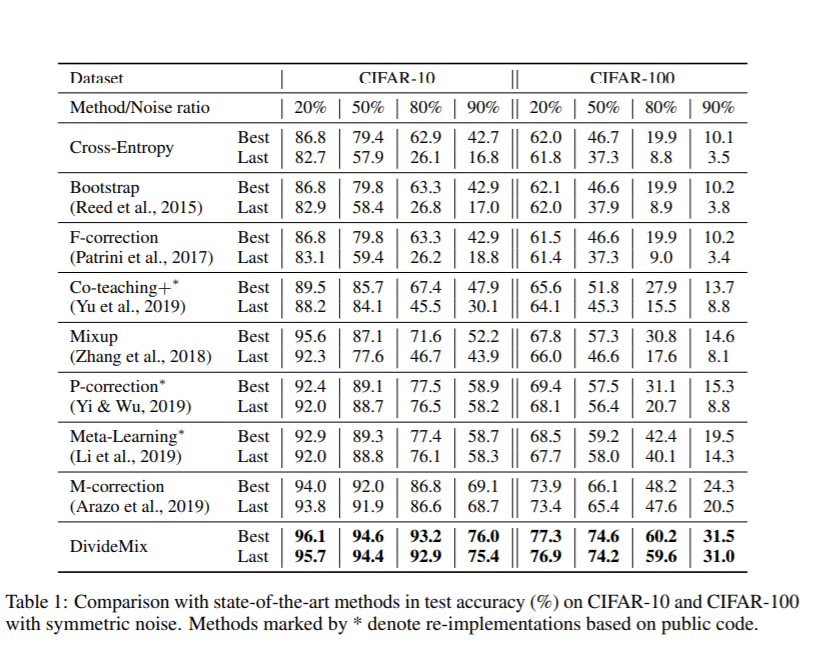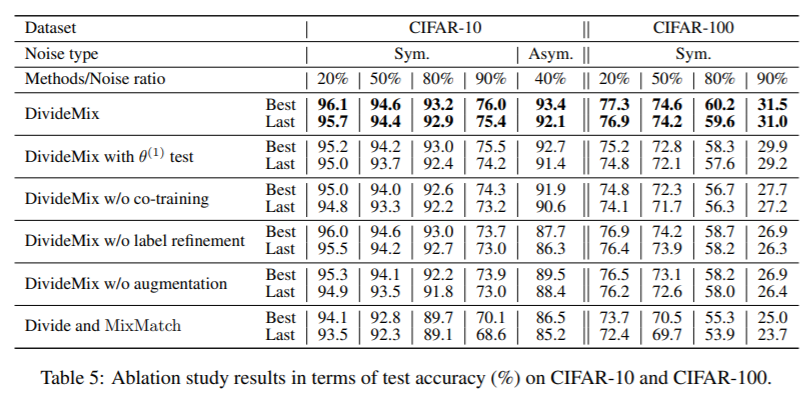User:Yktan
Presented by
Ruixian Chin, Yan Kai Tan, Jason Ong, Wen Cheen Chiew
Introduction
Much of the success in training deep neural networks (DNNs) is thanks to the collection of large datasets with human annotated labels. However, such labelling is time-consuming and expensive, especially for data that requires expertise such as medical data. Not only that, certain datasets will be noisy due to the biases introduced by different annotators.
There are a few existing approaches to use datasets with noisy labels. In learning with noisy labels (LNL), most methods take a loss correction approach. Another approach to reduce annotation cost is semi-supervised learning (SSL), where the training data consists of labeled and unlabeled samples.
This paper introduces DivideMix, which combines approaches from LNL and SSL. One unique thing about DivideMix is that it discards sample labels that are highly likely to be noisy and leverages these noisy samples as unlabeled data instead. This prevents the model from overfitting and improves generalization performance. Key contributions of this work are: 1) Co-divide, which trains two networks simultaneously, with the aim of improving generalization and avoiding confirmation bias. 2) During SSL phase, an improvement is made on an existing method (MixMatch) by combining it with another method (MixUp). 3) Significant improvements to state-of-the-art results on multiple conditions are experimentally shown while using DivideMix. Extensive ablation study and qualitative results are also shown to examine the effect of different components.
Motivation
Model Architecture
DivideMix leverages semi-supervised learning to achieve effective modelling. The sample is first split into a labelled set and an unlabeled set. This is achieved by fitting a Gaussian Mixture Model as a per-sample loss distribution. The unlabeled set is made up of data points with discarded labels deemed noisy. Then, to avoid confirmation bias, which is typical when a model is self-training, two models are being trained simultaneously to filter error for each other. This is done by dividing the data using one model and then training the other model. This algorithm, known as Co-divide, keeps the two networks from converging when training, which avoids the bias from occurring. Figure 1 describes the algorithm in graphical form.

For each epoch, the network divides the dataset into a labelled set consisting of clean data, and an unlabeled set consisting of noisy data, which is then used as training data for the other network, where training is done in mini-batches. For each batch of the labelled samples, co-refinement is performed by using the ground truth label [math]\displaystyle{ y_b }[/math], the predicted label [math]\displaystyle{ p_b }[/math], and the posterior is used as the weight, [math]\displaystyle{ w_b }[/math].
Then, a sharpening function is implemented on this weighted sum to produce the estimate, [math]\displaystyle{ \hat{y}_b }[/math]. Using all these predicted labels, the unlabeled samples will then be assigned a "co-guessed" label, which should produce a more accurate prediction. Having calculated all these labels, MixMatch is applied to the combined mini-batch of labeled, [math]\displaystyle{ \hat{X} }[/math] and unlabeled data, [math]\displaystyle{ \hat{U} }[/math], where, for a pair of samples and their labels, one new sample and new label is produced. More specifically, for a pair of samples [math]\displaystyle{ (x_1,x_2) }[/math] and their labels [math]\displaystyle{ (p_1,p_2) }[/math], the mixed sample [math]\displaystyle{ (x',p') }[/math] is:
[math]\displaystyle{ \begin{alignat}{2} \lambda &\sim Beta(\alpha, \alpha) \\ \lambda ' &= max(\lambda, 1 - \lambda) \\ x' &= \lambda ' x_1 + (1 - \lambda ' ) x_2 \\ p' &= \lambda ' p_1 + (1 - \lambda ' ) p_2 \\ \end{alignat} }[/math]
MixMatch transforms [math]\displaystyle{ \hat{X} }[/math] and [math]\displaystyle{ \hat{U} }[/math] into [math]\displaystyle{ X' }[/math] and [math]\displaystyle{ U' }[/math]. Then, the loss on [math]\displaystyle{ X' }[/math], [math]\displaystyle{ L_X }[/math] (Cross-entropy loss) and the loss on [math]\displaystyle{ U' }[/math], [math]\displaystyle{ L_U }[/math] (Mean Squared Error) are calculated. A regularization term, [math]\displaystyle{ L_{reg} }[/math], is introduced to regularize the model's average output across all samples in the mini-batch. Then, the total loss is calculated as:
,
where [math]\displaystyle{ \lambda_r }[/math] is set to 1, and [math]\displaystyle{ \lambda_u }[/math] is used to control the unsupervised loss.
Lastly, the stochastic gradient descent formula is updated with the calculated loss, [math]\displaystyle{ L }[/math], and the estimated parameters, [math]\displaystyle{ \boldsymbol{ \theta } }[/math].
Results
Applications
There are four datasets: CIFAR-10, CIFAR100 (Krizhevsky & Hinton, 2009)(both contain 50K training images and 10K test images of size 32 × 32), Clothing1M (Xiao et al., 2015), and WebVision (Li et al., 2017a). Two types of label noise are used in the experiments: symmetric and asymmetric. An 18-layer PreAct Resnet (He et al., 2016)is trained using SGD with a momentum of 0.9, a weight decay of 0.0005, and a batch size of 128. The network is trained for 300 epochs. The initial learning rate was set as 0.02, and reduce it by a factor of 10 after 150 epochs. The warm-up period is 10 epochs for CIFAR-10 and 30 epochs for CIFAR-100. For all CIFAR experiments, we use the same hyperparameters M = 2, T = 0.5, and α = 4. τ is set as 0.5 except for 90% noise ratio when it is set as 0.6.
Comparison of State-of-the-Art Methods
The effectiveness of DivideMix was shown by comparing the test accuracy with the most recent state-of-the-art methods: Meta-Learning (Li et al., 2019) proposes a gradient-based method to find model parameters that are more noise-tolerant; Joint-Optim (Tanaka et al., 2018) and P-correction (Yi & Wu, 2019) jointly optimize the sample labels and the network parameters; M-correction (Arazo et al., 2019) models sample loss with BMM and apply MixUp. The following are the results on CIFAR-10 and CIFAR-100 with different levels of symmetric label noise ranging from 20% to 90%. We report both the best test accuracy across all epochs and the averaged test accuracy over the last 10 epochs.

From table1, the author noticed that none of these methods can consistently outperform others across different datasets. M-correction excels at symmetric noise, whereas Meta-Learning performs better for asymmetric noise. DivideMix outperforms state-of-the-art methods by a large margin across all noise ratios. DivideMix outperforms state-of-the-art methods by a large margin across all noise ratios. The improvement is substantial (∼10% in accuracy) for the more challenging CIFAR-100 with high noise ratios.
DivideMix was compared with the state-of-the-art methods with the other two datasets: Clothing1M and WebVision. It also shows that DivideMix consistently outperforms state-of-the-art methods across all datasets with different types of label noise. For WebVision, DivideMix achieves more than 12% improvement in top-1 accuracy.
Ablation Study
The effect of removing different components to provide insights into what makes DivideMix successful. We analyze the results in Table 5 as follows.

The authors find that both label refinement and input augmentation are beneficial for DivideMix.
Conclusion
This paper has provided a new and effective algorithm for learning with noisy labels by leveraging SSL. The DivideMix method trains two networks simultaneously and utilizes co-guessing and co-labelling effectively, therefore it is a robust approach to dealing with noise in datasets. DivideMix has also been tested using various datasets with the results consistently being one of the best when compared to other advanced methods.
References
Eric Arazo, Diego Ortego, Paul Albert, Noel E. O’Connor, and Kevin McGuinness. Unsupervised label noise modeling and loss correction. In ICML, pp. 312–321, 2019.
David Berthelot, Nicholas Carlini, Ian J. Goodfellow, Nicolas Papernot, Avital Oliver, and Colin Raffel. Mixmatch: A holistic approach to semi-supervised learning. NeurIPS, 2019.
Yifan Ding, Liqiang Wang, Deliang Fan, and Boqing Gong. A semi-supervised two-stage approach to learning from noisy labels. In WACV, pp. 1215–1224, 2018.